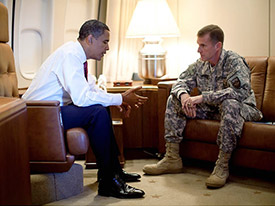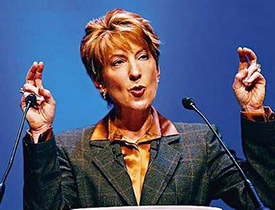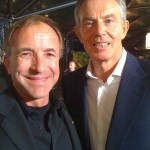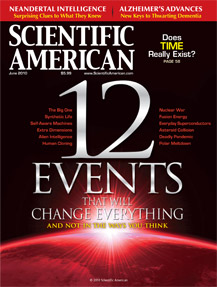The recent flap over the inopportune comments by General Stanley McChrystal and his staff in the presence of and even directly to a Rolling Stone magazine journalist, and the ensuing hue and cry “off with their heads” for what amounts to something akin to alcohol-fueled barroom B.S.ing and locker-room boys-will-be-boys jock talk, affords an opportunity to distinguish between public talk and private talk.

Private talk is what we say in private to our spouses, family, friends, and colleagues when there is a presumption of privacy such that one’s comments will not go public. Public talk is what we say when we want to make a formal statement or declaration with the intention of and responsibility for what was said. Too often we confuse these two very different forms of expression. Everyone is treating the private talk of McChrystal and his staff as if it were intended for public consumption. It is almost as if McChrystal had held a press conference and issued a formal public statement that Joe Biden’s new name is “bite me.” Surely we should recognize the vast gulf that exists between these two types of talk, and no one would want to insist that all private talk be held as if there were a microphone in the room that was on and broadcasting. Locker rooms and barrooms would go deadly silent.

Something similar happened to California Senatorial candidate Carly Fiorina the day of the primary election, when she was caught mocking the hair of her rival Sen. Barbara Boxer when she thought that her microphone was off, continuing with her private talk about Fox’s Sean Hannity and the cheeseburgers she wished she had eaten the night before.
And let’s not forget last year’s “climategate” flap in which the public discovered that scientists—shock of all shocks—are people who in private talk like everyone else, making fun of colleagues they don’t like, dissing rivals and competitors, and speaking colloquially as if they were not scientists investigating one of the most politically charged scientific issues of the past century—anthropogenic global warming.

On the other hand, if you are a General in charge of executing a war, a Senatorial candidate with aspirations of being one of the handful of people who can actually influence public policy, or a scientist who data and theory could alter entire economies for decades or even centuries, your private talk is not the same as that of everyone else’s. McChrystal knew he was talking to a Rolling Stone reporter, so as the head of hundreds of thousands of combat troops under the ultimate direction of the Commander-in-Chief at 1600 Pennsylvania Ave., he should have been able to filter out his private talk. Ditto Carly Fiorina who, if she wins the Senate seat of a state whose economy rivals that of most countries, is bound to sit before microphones on almost a daily basis, so if she cannot discriminate between public and private talk now, had damn well better learn the difference. Likewise scientists whose opinions on climate change are used by politicians and policy makers worldwide to shape the direction of economic reform, have an obligation to presume that much of their private talk will be used publicly against them (and their recommendations) by those who disagree.
In other words, if you are in a position of power and influence, assume that the microphone is on.
Comments Off on ‘I didn’t know the mic was on’: Public Talk v. Private Talk
Last week I blogged about lying: “Everyone Lies: Why?”
Deception is one thing, self deception is quite another. This week TED.com has posted my new TED talk, delivered at the last TED conference, in which I present material from my forthcoming book on the neuroscience of belief, tentatively entitled The Believing Brain, a central theme of which is how we are so easily deceived and how we deceive ourselves. Here is a brief summary of the thesis of the talk, although because it is so visual I strongly recommend watching the TED video.
Souls, spirits, ghosts, gods, demons, angels, aliens, intelligent designers, government conspiracists, and all manner of invisible agents with power and intention are believed to haunt our world and control our lives. Why?
The answer has two parts, starting with the concept of patternicity, which I define as the human tendency to find meaningful patterns in meaningless noise. The face on Mars, the Virgin Mary on a grilled-cheese sandwich, Satanic messages in rock music. Of course, some patterns are real: finding predictive patterns in changing weather, fruiting trees, migrating prey animals and hungry predators was central to the survival of Paleolithic hominids.
The problem is that we did not evolve a baloney-detection device in our brains to discriminate between true and false patterns. So we make two types of errors: a Type I error, or false positive, is believing a pattern is real when it is not; a Type II error, or false negative, is not believing a pattern is real when it is. If you believe that the rustle in the grass is a dangerous predator when it is just the wind (a Type I error), you are more likely to survive than if you believe that the rustle in the grass is just the wind when it is a dangerous predator (a Type II error). Since the cost of making a Type I error is less than the cost of making a Type II error, and since there’s no time for careful deliberation between patternicities in the split-second world predator-prey interactions, natural selection would have favored those animals most likely to assume that all patterns are real.
But we do something other animals do not do. As large-brained hominids with a developed cortex and a “theory of mind”—the capacity to be aware of such mental states as desires and intentions in both ourselves and others—we practice what I call agenticity: the tendency to believe that the world is controlled by invisible intentional agents. That is, we often infuse the patterns we find with agency, and believe that these intentional agents control the world, sometimes invisibly from the top down (as opposed to bottom-up causal randomness). Together, patternicity and agenticity form the cognitive basis of shamanism, paganism, animism, polytheism, monotheism, and all modes of Old and New Age spiritualisms.
Agenticity carries us far beyond the spirit world. The Intelligent Designer is said to be an invisible agent who created life from the top down. Aliens are often portrayed as powerful beings coming down from on high to warn us of our impending self-destruction. Conspiracy theories predictably include hidden agents at work behind the scenes, puppet-masters pulling political and economic strings as we dance to the tune of the Bildebergers, the Rothchilds, the Rockefellers or the Illuminati.
There is now substantial evidence from cognitive neuroscience that humans readily find patterns and impart agency to them, well documented in the University of Bristol psychologist Bruce Hood’s new book SuperSense (HarperOne, 2009). Examples: Children believe that the sun can think and follows them around and they often add smiley faces on sketched suns. Adults typically refuse to wear a mass murderer’s sweater, believing that “evil” is a supernatural force that imparts its negative agency to the wearer (and, alternatively, that donning Mr. Rogers’ cardigan will make you a better person). A third of transplant patients believe that the donor’s personality is transplanted with the organ. Genital-shaped foods (bananas, oysters) are often believed to enhance sexual potency. Subjects watching geometric shapes with eyespots interacting on a computer screen infer that they represent agents with moral intentions.
“Many highly educated and intelligent individuals experience a powerful sense that there are patterns, forces, energies, and entities operating in the world,” Hood explains. “More importantly, such experiences are not substantiated by a body of reliable evidence, which is why they are supernatural and unscientific. The inclination or sense that they may be real is our supersense.”
We are natural-born supernaturalists.
Comments Off on The Pattern Behind Self Deception
How free exchange between people
increases prosperity and trust
In his 1776 work An Inquiry into the Nature and Causes of the Wealth of Nations, Scottish moral philosopher Adam Smith identified the cause in a single variable: “the propensity to truck, barter, and exchange one thing for another.” Today we call this free trade or market capitalism, and since the recession it has become de rigueur to dis the system as corrupt, rotten or deeply flawed.
If we pull back and take a long-horizon perspective, however, the free exchange between people of goods, services and especially ideas leads to trust between strangers and prosperity for more people. Think of it as ideas having sex. That is what zoologist and science writer Matt Ridley calls it in his book The Rational Optimist: How Prosperity Evolves. Ridley is optimistic that “the world will pull out of the current crisis because of the way that markets in goods, services and ideas allow human beings to exchange and specialize honestly for the betterment of all.” (continue reading…)
read or write comments (1)
The Force of Ideas Over the Force of Arms

Shermer and Tony Blair
Last week I attended the Khosla Ventures summit at Cavello Point in Sausalito, California, an ex-army base converted to a posh resort, where the venture capitalist (he calls himself a “venture assistant”) Vinod Khosla brings together start-up CEOs and their venture backers who are together innovating new science and technologies for alternative and environmentally efficient energy sources. Vinod heard my TED talk in Long Beach in February 2010 (to be posted at TED.com in June) and invited me to explain why people believe weird things about money (“The Mind of the Market”, based on my book of the same title). Vinod hosted a fireside chat with Bill Gates and Tony Blair, and in the Q & A I raised my hand and asked Tony a question. By way of background…
Since I am in the business of spreading good ideas and debunking bad ideas, I ask this question all the time of a diverse range of people, in search of different answers to this difficult question. I believe in the power of ideas to free people and empower them—a fundamental principle that was born of the Enlightenment—but I also recognize that not everyone shares this belief, and since one of those Enlightenment principles is the freedom to disagree and the right to think and believe whatever you want as long as it does not interfere with my rights, then we can’t force people to embrace these Enlightenment values. On the other hand, we are tribal and we still live in a world with walls that are guarded by men with guns, and there are other tribes who would just as well terminate our existence or replace our Constitutional liberties with theocratic rule, we need a strong military. Thus my question for Tony Blair, and his eloquent and insightful answer:
Michael Shermer: “How can we spread liberal democracy, market capitalism, science, technology, education, the Internet, etc. globally, when there are people who are still essentially living in theocracies who, as you said, would just assume see us dead, who don’t believe in the education of women and children, who don’t believe in civil liberties and equal treatment under the law, etc., and how can we do so non-militarily? That is, how do we spread these ideas without imposing them on other people?”
Tony Blair: “It’s one of the great myths perpetrated in our own societies is that somehow people who live in oppressive or backward looking governments actually prefer it that way and that we just don’t understand their culture. You will often hear this in certain countries about the role of women when it is usually men talking about it, but any time you get the opportunity to talk to any women in those countries separated from those who might overhear them, believe it or not they tell you that they would prefer to be free and equal.”
“We have allies in this fight who are the people, most of whom want change. The thing is, however, you need the security means to stand up when you are confronted to answer back, and if you don’t you will get rolled over by them and there’s no use in thinking any different. However, the ultimate answer is not the force of arms but the force of ideas.”
“I think the 20th century was the century of fundamentalist political ideology, but the 21st century is going to be about religious or cultural ideology. The single most important thing we can do is also to provide a basis for peaceful co-existence. The best way of defeating these ideas is with better ideas. The better idea that we have in our way of life is not just about freedom and democracy, although I think those are important elements, it’s also about a basic concept of justice—the basic idea that anyone, no matter what their background, will get a chance to succeed.”
Comments Off on Tony Blair’s Answer
Michael Shermer enjoys two books that examine economics and politics from a scientific perspective — one explaining the experimental basis for democracy, another placing trade in an evolutionary context.
Reviews of The Science of Liberty: Democracy, Reason, and the Laws of Nature by Timothy Ferris, and The Rational Optimist: How Prosperity Evolves by Matt Ridley. This piece was published in Nature magazine on May 20, 2010.
In a 1963 lecture, Nobel-prizewinning physicist Richard Feynman opined on the nature of politics, arguing that the US governmental system “is new, it’s modern, and it is scientific”. Feynman reasoned that the way in which the system had been designed from scratch in the eighteenth century made it flexible enough to evolve as ideas were “developed and tried out and thrown away”. The writers of the Constitution, he noted, knew of the value of doubt.
Two new books discuss how science underpins democracy and trade. Timothy Ferris argues in The Science of Liberty that the experimental nature of liberal democracies is no accident, and in The Rational Optimist, Matt Ridley examines economics in the light of evolution.
Most science historians attribute the rise and success of the scientific enterprise to the Enlightenment values of reason, empiricism and anti-authoritarianism. Ferris reverses the causal vector. Most of the founding fathers were serious amateur scientists who deliberately adopted methods of data gathering, hypothesis testing and theory formation. Thomas Paine, for example, was an amateur astronomer who speculated that every star is a sun like our own, with orbiting planets. Assuming that science is universal, he believed that inhabitants of other worlds would discover the same natural and social laws as ours. “All the great laws of society are laws of nature,” Paine wrote in his 1791 treatise The Rights of Man. (continue reading…)
Comments Off on Science, Freedom and Trade






